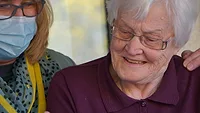Wireless Meets the Trend of Assisted and Independent Living
Nurse Call Systems
New wireless technology allows for the simple and rapid installation into any building. “The industry is changing, and hardly anyone is building skilled nursing homes any more,” notes Jerry Johnson. As a industrial engineer by training, and ten-year president of Cornell Communications, Inc. Milwaukee, Wis., a manufacturer of hospital and personal emergency response systems (PERS), Johnson is well versed in integrating technology into healthcare facilities.According to Johnson, even the recent building boom of Alzheimer’s homes is beginning to wane in light of the greater demand for the less staff-intensive community care homes and their ilk. Even if the staff assists residents with some activities of daily living such as preparing some meals and medication monitoring, this still requires much less time, and qualifications, than that required within skilled nursing homes.
Meeting the challenge of fitting new solutions to old buildings. Prospective owners and operators oftentimes face the challenge of retrofitting existing residential homes, such as hotels or apartment buildings, to meet the regulations of caring for seniors. Yet, putting in a emergency response system after the fact can present physical and financial challenges.
“Putting in a wired system can still add up to a lot because now you have to bore holes in new walls and studs to string the wires. This extra expense can jeopardize the economic health of any facility,” says Johnson.
“Another problem lies with existing nursing-home buildings that already have an older, outdated nurse call system,” adds Johnson. “There’s a tremendous inspection process in re-certifying a building, and one of the first things the inspectors look for is, is the nurse call system working. To avoid huge fines of thousands of dollars per day, operators are finding it cheaper to install a new wireless system rather than have an electrical contractor trouble-shoot and replace all the old wiring.”
Wireless A Success
In basic layout, wireless systems share some similarities with traditional wired systems. Each unit in a retirement or community care home will have at least one room (usually the bathroom) with a wall mounted call-for-help station with a pull string—or a bedside mounted push button for activation of the alarm. Once activated, a buzzer, bell or light will go off at the reception desk to alert staff of an emergency.By relying on ultra high-frequency radio waves, a wireless system allows through-the-air communication between a tiny wall-mounted transmitter —in any room—and the receiving station at the reception desk or directly to the staff via pocket pager. Typically, the master receiving station will be hooked up to a 110 volt AC source, but the transmitter/sending units only require a standard 9-volt DC battery, so they can be placed at almost any location. Changing or adding locations from a bathroom to a bedroom or kitchen can be accomplished in minutes.
Wireless systems also allow “non-fixed” sources of help signals. For instance, the Cornell system offers a small wireless pendant that patients can wear around their neck, wrist or within a pocket.
In all cases, the success of any wireless emergency response system, especially within a large building or a campus setting, relies on its ability to span large distances with a strong signal.
“One commonly used measurement is called ‘open field range,’” says Johnson. “This is the distance that the signal will travel across a open space. A typical system might cover 1600 feet. Cornell makes a system that traverses 3500 feet. Yet, an even better way to measure distance is referred to as the ‘rated range.’ It is a tenth of the open field range. With this figure, an open field range of 3500 feet would yield a rated range of 350. But since that figure acts like a radius, you could conceivably provide coverage over every inch of a building that was two football fields in length and 35 stories tall with a single, centrally mounted nursing station.”
“We use military grade components in their systems, the same components that are being installed by the U.S. State Department at American embassies throughout the world,” notes Johnson. “These have to be rugged, fail-safe systems, so they are very difficult to jam with outside frequencies. This means that if a nurse or receptionist inadvertently places a television, laptop computer, or even a fan next to the central nurse call receiver, that the system will ignore this electronic ‘noise’ and still operate reliably.”
With the Cornell system, for example, there is a one-in-fifteen-million unique identification signal for every transmitter, so false alarms are greatly eliminated.
“The other important thing to look for, is that the system is UL approved,” cautions Johnson. “Everything has to be up to code.”
“With some emergency response systems, the receptionist has to operate a computer to run the system, but we all know that computers crash on occasion,” says Johnson. “I wouldn’t trust my life to a computer, and neither would your residents.”
Reassurance to Patients and Staff
Some of the more recent wireless systems go beyond the basics by adding features that console patients and home operators alike.“Tactile elements should be included with room alarm stations. For instance, a large alarm button could be designed in the shape of a red cross, so the patient can feel it even in dark. Lastly, all stations have a “call confirmation” LED light that flashes when the button is pressed or the pull cord is tugged, reassuring the patient once more that help has been summoned.”
The theme of reassurance through two-way communication is carried forward with new check-in stations.
At the reception desk, either a master station printer or optional computer display can be used to track all of the patients who have checked in by a certain time. The person on duty can then look at the printout or screen to determine if anyone is missing. Reports can be generated to document that all residents were accounted for.
Also a result of wireless technology, added security arrives in the form of alarm pagers that can be carried by the retirement home’s staff.
Looking for a reprint of this article?
From high-res PDFs to custom plaques, order your copy today!






